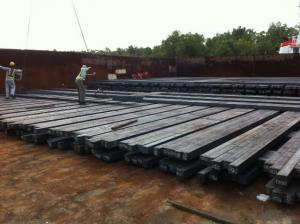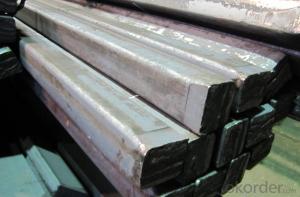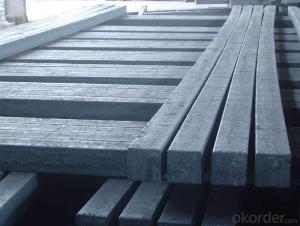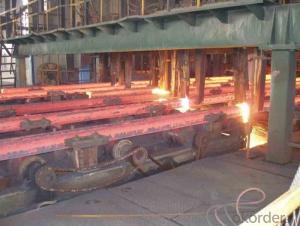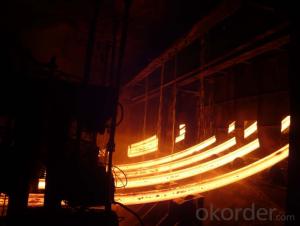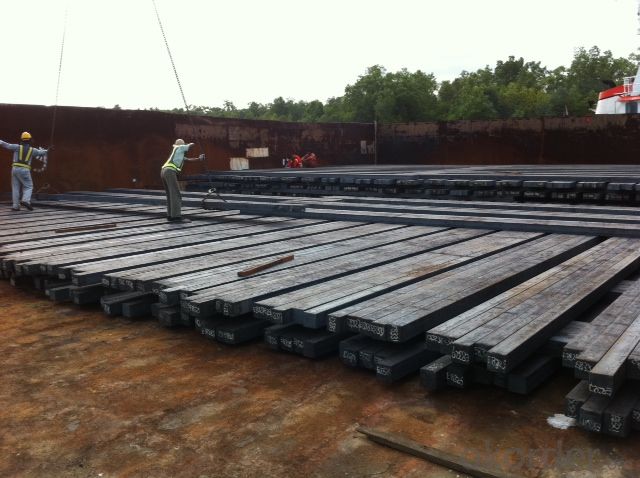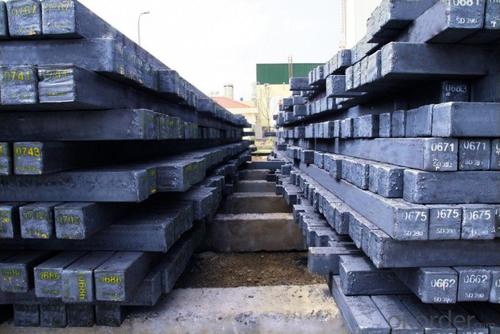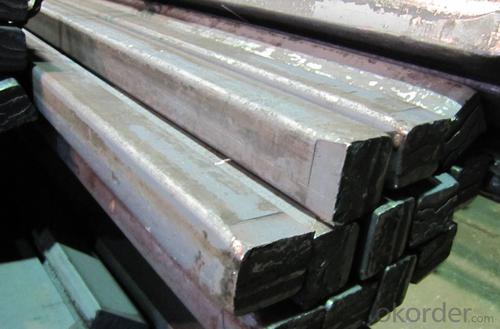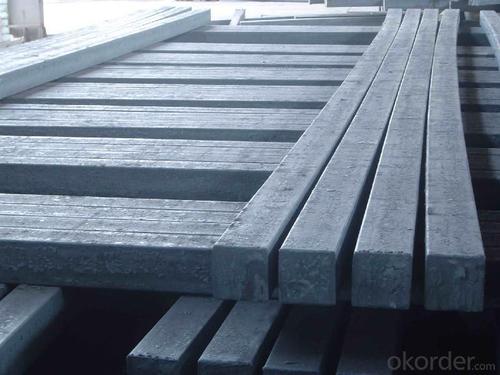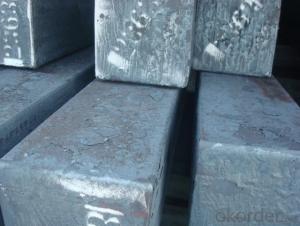Square Steel Billet Q235 3SP Grade Prime Quality 4#
- Loading Port:
- Tianjin
- Payment Terms:
- TT OR LC
- Min Order Qty:
- 2000 m.t
- Supply Capability:
- 50000 m.t/month
OKorder Service Pledge
OKorder Financial Service
You Might Also Like
Description of Square Steel Billet Q235 3SP Grade Prime Quality 4#
M. S. Billets are used for rolling of TMT Re-Bars of Fe415 and Fe500 Grade and various other structural steel products.
CRS Billets are used for rolling of CRS TMT Re-Bars.
Special Alloy Billets are used for rolling of any special grade TMT Re-Bars like Earthquake resistant TMT Re-Bars and for special grade structural steel products.
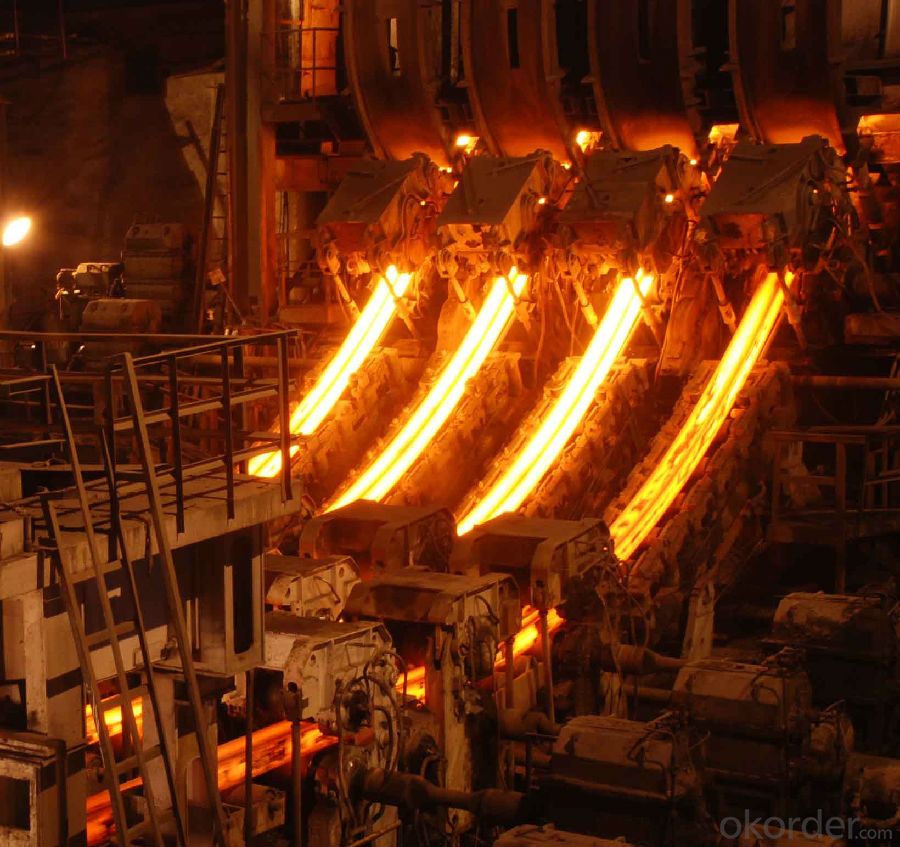
Main Feature Square Steel Billet Q235 3SP Grade Prime Quality 4#
Raw elements(C,Fe,Ni,Mn,Cr,Cu.)---Smelted ingots by AOD finery---hot rolled into black suface---pickling in acid liquid---cold drawn----polished by automatically machine--- cutting into pieces---checking quanlity
Applications of Square Steel Billet Q235 3SP Grade Prime Quality 4#
Widely Used in the areas such as Stainless Steel Fasteners, Chains, Kitchen and Sanitary wares, Furniture handles, Handrails, Electroplating and Electrolyzing pendants, Foods, Electron, Petroleum, Construction and Decoration, etc. Products have a high strength after cold-working. Electronic products parts, Medical appliance, Springs, Bus Inside and Outside packaging and building, Street Lamp Posts, etc. Decoration materials and Outdoor Publicity Billboard. Used for the products which have the Anti-Stress Corrosion requirement. Electron Products, Table-wares, Bolts, Nuts, Screen Meshes, Cumbustors and so on.
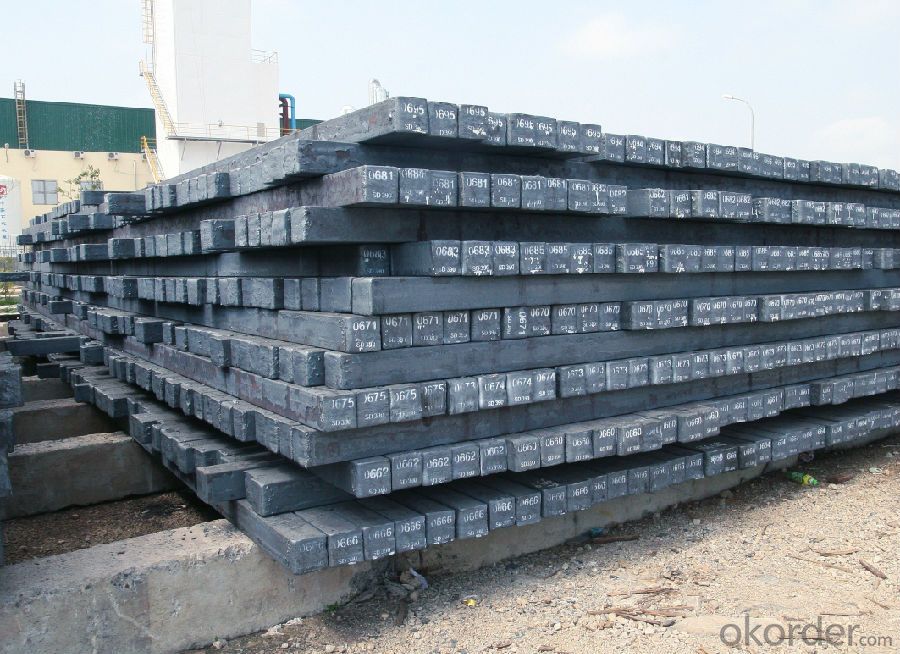
Specifications of Square Steel Billet Q235 3SP Grade Prime Quality 4#
| Standard | C(%) | Mn(%) | S(%) | P(%) | Si(%) |
| Q195 | ≤0.12 | ≤0.50 | ≤0.040 | ≤0.035 | ≤0.30 |
| Q235 | ≤0.20 | ≤1.40 | ≤0.045 | ≤0.045 | ≤0.35 |
| Q275 | ≤0.22 | ≤1.50 | ≤0.045 | ≤0.045 | ≤0.35 |
| 20MnSi | 0.17-0.25 | 1.2-1.6 | ≤ 0.050 | ≤ 0.050 | 0.40-0.80 |
| 3SP | 0.14-0.22 | 0.40-0.85 | ≤ 0.050 | ≤ 0.040 | 0.05-0.15 |
| 5SP | 0.28-0.37 | 0.50-1.00 | ≤ 0.050 | ≤ 0.040 | 0.15-0.30 |
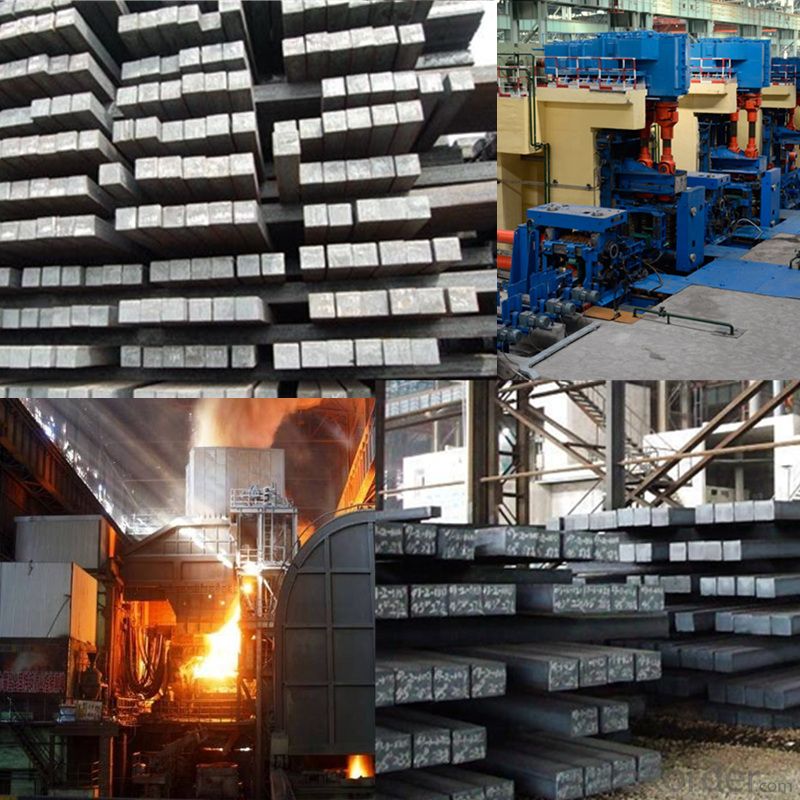
FAQ of Square Steel Billet Q235 3SP Grade Prime Quality 4#
We have organized several common questions for our clients,may help you sincerely:
1. How Can I Visit There?
Our company is located in Tianjin City, China, near Beijing. You can fly to Tianjin Airport Directly. All our clients, from home or aboard, are warmly welcome to visit us!
2. How Can I Get Some Sample?
We are honored to offer you sample.
3. Why choose CNBM?
Our delivery time about 15-20days for standard sizes, if you have other requirements like hardness, quanity and width ,it is about 20-40days. But don't worry we also try our best for the delivery time ,because time longer and our cost is higher.
- Q: How are steel billets used in the production of pressure vessels?
- Steel billets are used in the production of pressure vessels as the starting material for forging, rolling, or extrusion processes. These billets are heated and shaped into the desired form, such as plates or shells, which are then welded together to create the pressure vessel. The high strength and durability of steel billets ensure that the pressure vessel can withstand the high internal pressure and harsh operating conditions it may be subjected to.
- Q: Can steel billets be used in high-temperature applications?
- Yes, steel billets can be used in high-temperature applications. Steel is known for its high strength and heat resistance, which makes it suitable for various high-temperature environments such as furnaces, boilers, and industrial ovens. Additionally, steel can retain its mechanical properties and structural integrity even at elevated temperatures, making it a reliable choice for such applications.
- Q: How do steel billets contribute to the overall weight reduction of a structure?
- There are several ways in which steel billets contribute to reducing the overall weight of a structure. Firstly, through a process called continuous casting, steel billets can be precisely shaped and sized, resulting in lighter and more compact billets. This, in turn, decreases the weight of the structure. Secondly, advanced alloys and compositions can be used to make steel billets with high strength-to-weight ratios. These alloys are specifically designed to provide the same level of strength and durability as traditional steel, but with a lower weight. By incorporating these lightweight steel billets into the construction of a structure, the overall weight can be significantly reduced without sacrificing strength and performance. In addition, steel billets can be employed in the manufacturing of complex shapes and structures using techniques such as extrusion and forging. These methods allow for the creation of intricate designs and structures, eliminating the need for additional components and reducing the overall weight of the structure. Furthermore, steel billets can be used in the construction of lightweight structural elements such as beams, columns, and trusses. These elements can be designed to have hollow sections or thinner profiles, which reduces the amount of steel needed while still maintaining structural integrity. This results in a substantial decrease in the overall weight of the structure. In conclusion, steel billets contribute to weight reduction in structures by enabling the production of lighter and more compact components, utilizing advanced alloys with high strength-to-weight ratios, allowing for the creation of complex shapes and structures, and facilitating the construction of lightweight structural elements.
- Q: What are the main challenges in the production of steel billets?
- The production of steel billets, which are semi-finished products that serve as the raw material for various steel products, involves several challenges. One of the main challenges is ensuring consistent and high-quality raw materials. Steel billets are typically produced from scrap metal or iron ore, and obtaining a reliable supply of these materials can be challenging due to fluctuations in availability and cost. Another challenge is achieving the desired chemical composition and mechanical properties of the steel billets. The production process involves various steps such as melting, refining, and casting, and each step must be carefully controlled to achieve the desired outcome. Maintaining precise control over the temperature, alloying elements, and impurities during these processes is crucial to ensure the final product meets the required specifications. The choice of casting method is also important in the production of steel billets. Casting can be done through continuous casting or ingot casting, and each method has its own advantages and disadvantages. Continuous casting is more commonly used as it offers higher productivity and better control over the final product's dimensions and surface quality. However, continuous casting requires sophisticated equipment and expertise to maintain a stable and continuous process. The cooling and solidification process after casting is also a critical challenge in steel billet production. Proper cooling is essential to avoid defects such as cracks, segregations, or uneven microstructures. The cooling rate needs to be carefully controlled to achieve the desired microstructure and mechanical properties of the billets. Furthermore, the handling and storage of steel billets can present challenges. Billets are often transported and stored in large quantities, and maintaining their quality and preventing damage during these processes is important. Proper handling equipment, storage conditions, and logistics management are necessary to minimize any potential damage or loss. Lastly, environmental considerations are increasingly important in steel billet production. The process can generate significant amounts of emissions, waste, and energy consumption. Meeting environmental regulations and implementing sustainable practices, such as recycling scrap metal or reducing energy consumption, can pose challenges but are crucial for the long-term viability of the industry. In summary, the main challenges in the production of steel billets include ensuring consistent and high-quality raw materials, achieving the desired chemical composition and mechanical properties, choosing the appropriate casting method, controlling the cooling and solidification process, handling and storage, and addressing environmental concerns. Overcoming these challenges requires a combination of advanced technology, skilled workforce, and efficient management practices in the steel production industry.
- Q: How are steel billets used in the production of hydraulic components?
- Steel billets are an essential raw material used in the production of hydraulic components. These billets, which are semi-finished forms of steel, serve as the starting point for manufacturing various hydraulic parts. To begin with, steel billets are heated to high temperatures to make them malleable. This process is known as hot rolling, and it allows the billets to be easily shaped and formed into the desired hydraulic component. The hot billets are then passed through a series of rollers to achieve the desired size and shape, such as bars, rods, or tubes. Once the steel billets have been shaped, they undergo further machining processes to create specific hydraulic components. For example, they may be cut, drilled, or threaded to form pistons, cylinders, valve bodies, or other essential parts used in hydraulic systems. The use of steel billets in hydraulic component production offers several advantages. Firstly, steel is known for its high strength and durability, making it an ideal material for hydraulic applications where components are subjected to high pressure and heavy loads. Additionally, steel's excellent corrosion resistance ensures the longevity of hydraulic components, even in harsh operating conditions. Furthermore, steel billets allow for precise dimensional control during the manufacturing process. This ensures that the hydraulic components meet the required specifications and can seamlessly integrate into hydraulic systems without any compromise in performance. In conclusion, steel billets play a crucial role in the production of hydraulic components. By starting with these semi-finished forms of steel, manufacturers can create high-quality, durable, and precisely engineered parts that are vital for the efficient operation of hydraulic systems.
- Q: How are steel billets used in the production of railway tracks?
- Steel billets are the raw materials used in the production of railway tracks. They are heated, shaped, and rolled to form long, flat bars known as rails. These rails are then laid on the trackbed, forming the foundation for the tracks on which trains run.
- Q: Can steel billets be used for making kitchen utensils?
- Kitchen utensils can indeed be made using steel billets, which serve as raw materials that can be molded and crafted into various products. These steel billets must possess certain qualities like resistance to corrosion, durability, and the ability to withstand heat if they are to be used for kitchen utensils. The process of creating these utensils involves melting and casting the steel billets, which are then forged into the desired shapes and sizes. This allows for the production of knives, spoons, forks, cookware, and other utensils. To improve performance and appearance, the steel used in kitchen utensils is often treated and finished. Ultimately, steel billets play a crucial role in the manufacturing process of kitchen utensils by providing the necessary raw material needed to create durable and functional tools for cooking and food preparation.
- Q: How are steel billets tested for strength and durability?
- To ensure the strength and durability of steel billets, rigorous examinations and tests are conducted. The objective is to verify that the billets possess the necessary properties to withstand their intended application and perform optimally in diverse conditions. The tensile strength test is a key evaluation performed on steel billets. This involves gradually increasing the axial load on the billet until it reaches its breaking point. By measuring the applied force and resulting deformation, the ultimate tensile strength can be determined. This test assesses the steel's ability to resist external forces and provides vital information about its structural integrity. Another crucial assessment is the hardness test, which measures the steel billet's resistance to indentation or scratching. Various methods, such as the Brinell, Rockwell, or Vickers hardness tests, can be used to determine the hardness value. This information helps evaluate the billet's resistance to wear, deformation, and potential damage. Heat treatment is also vital in testing the strength and durability of steel billets. This process involves controlled heating and cooling cycles to modify the billets' microstructure, resulting in improved mechanical properties. By carefully monitoring temperature, time, and cooling rate during heat treatment, desired properties like increased strength and toughness can be achieved. Furthermore, non-destructive testing techniques, like ultrasonic testing, magnetic particle inspection, and radiographic examination, are employed to assess internal quality and identify any potential defects or flaws in the billets. These methods provide valuable information about the billet's structural soundness, ensuring it meets required standards and specifications. Additionally, chemical composition analysis is conducted to verify the elemental composition of the steel billets. This analysis ensures that the alloying elements are within specified limits, as they significantly affect mechanical properties. Any deviation from the required composition could compromise strength and durability. In conclusion, steel billets undergo a comprehensive series of tests and evaluations to ensure strength and durability. These include tensile strength testing, hardness testing, heat treatment, non-destructive testing, and chemical composition analysis. By subjecting the billets to these assessments, manufacturers can guarantee the quality of their steel products, ensuring they meet the demanding requirements of various applications.
- Q: How are steel billets used in the manufacturing of gears and bearings?
- Gears and bearings rely heavily on steel billets as a vital raw material during their manufacturing process. These billets, which are semi-finished steel products, are typically cast into rectangular or square shapes. They act as the starting point for producing different components utilized in gears and bearings. Regarding gears, steel billets are initially cut into smaller sections to create gear blanks or rough gear shapes. These blanks then undergo a series of operations, including forging, machining, and heat treatment. Forging involves shaping the gear blank using compressive forces, enhancing the mechanical properties of the steel and aligning the grain structure for increased strength. Subsequently, machining is employed to eliminate excess material, refine the shape, and form the gear teeth. Ultimately, heat treatment is applied to enhance the hardness, toughness, and wear resistance of the gear. Similarly, in bearing manufacturing, steel billets are transformed into various components such as inner and outer rings, balls or rollers, and cages. Initially, the billets are cut and shaped into rough rings, which are further processed through machining operations to attain the desired dimensions and precision. Often, the rings undergo heat treatment to enhance their hardness, improve surface finish, and increase resistance to wear and fatigue. The balls or rollers are also produced from steel billets using a similar process, while cages are typically fabricated separately using sheet metal. In summary, steel billets play a vital role in the manufacturing of gears and bearings. They serve as the foundational material, undergoing various shaping, machining, and heat treatment processes to create the final components with the required strength, durability, and precision. The quality of the steel billets used significantly impacts the performance and longevity of gears and bearings, thus making them an essential aspect of the entire manufacturing process.
- Q: How are steel billets cooled after the manufacturing process?
- After the manufacturing process, steel billets undergo a cooling procedure called water quenching, which involves immersing them in a water bath or spraying high-pressure water onto them. By rapidly cooling the billets, the microstructure of the steel is controlled, resulting in desired properties like increased strength and hardness. Water quenching is favored for its efficient and uniform cooling, ensuring consistent quality in the billets. Moreover, it is a cost-effective option compared to other cooling methods. However, it is worth noting that the cooling process may differ depending on the specific requirements of the steel being produced, leading to the utilization of alternative cooling methods like air cooling or oil quenching.
Send your message to us
Square Steel Billet Q235 3SP Grade Prime Quality 4#
- Loading Port:
- Tianjin
- Payment Terms:
- TT OR LC
- Min Order Qty:
- 2000 m.t
- Supply Capability:
- 50000 m.t/month
OKorder Service Pledge
OKorder Financial Service
Similar products
Hot products
Hot Searches
Related keywords
